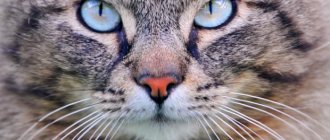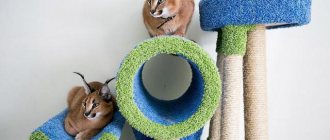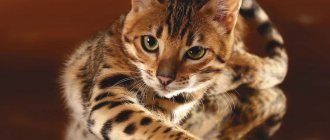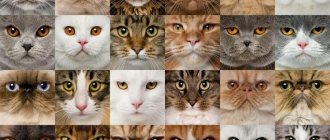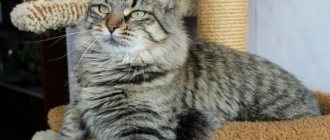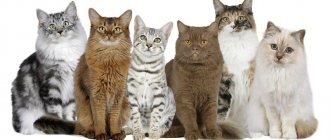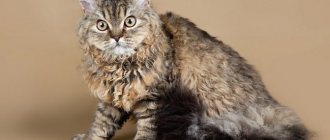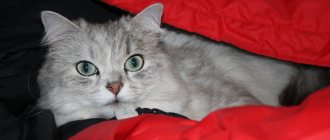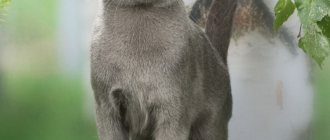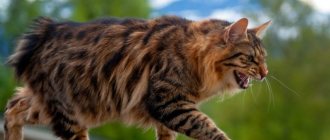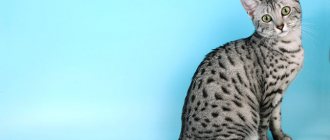Cats have long taken their rightful place on the list of the most popular pets. But many people are not ready to put up with heavy shedding and it is because of this that they deny themselves the pleasure of having a purring pet. Especially for them, breeders have developed several breed varieties, whose fluff does not settle in clumps on clothes and furniture.
Let's figure out which cat breeds don't shed and what to do to prevent them from smelling.
Features of shedding in pets
Shedding is a natural process accompanied by the loss of dead hairs. In the wild, it is seasonal, that is, it is observed only a couple of times a year: in spring and autumn. These seasons were not chosen by chance, but because of a sharp change in temperature, forcing them to change their fur coat to a lighter or warmer one.
At home, shedding often occurs on an ongoing basis. The most intense period occurs during the heating season, when the microclimate in the house suddenly changes to warm and dry due to the inclusion of central heating.
The intensity of fur shedding depends on its structure. The highest is typical for long-haired cats and pets with thick undercoat. The latter cause the most inconvenience, because their thin fluff scatters very quickly and settles literally everywhere. It not only spoils the appearance of furniture and clothing, but also easily penetrates the respiratory tract and eyes, provoking allergy attacks.
Werecat or Lykoi
If we really delve into the exotic, then those who like scarier things will definitely appreciate Likoi. This incredible breed in appearance really resembles a half-wolf, half-cat. The pet of this breed is not completely bald. Its coat simply has an uneven distribution, which gives it a somewhat frightening and folkloric appearance.
The fur of an adult may be completely absent or partially present on the body. The back is usually colored a smoky black, and the coat is ragged in texture. The body is quite flexible and at the same time strong. The head is wedge-shaped. This breed of hairless cats, if it can be classified as such, appeared due to a mutation. The latter manifested itself in the development of hair follicles.
Expert opinion
Danilova Maria Alekseevna
Therapist, dentist, ophthalmologist, surgeon, express tests, ratologist, groomer.
If compared with the same Dwelf and Elf, then the Likoi received official status as a separate type of cat. This happened in 2012.
Which cats shed the least?
Animals that hardly shed include cats without undercoat, hairless breeds, and pets with curly coats. Unlike their counterparts, they leave behind much less fur and are also less likely to cause allergies in their owners.
Siamese-oriental group
This group includes “mustaches” from warm countries, devoid of undercoat. Among the main representatives are the following breeds:
- Siamese;
- oriental;
- Thai;
- Balinese;
- Abyssinian;
- Burmese;
- skiff-toy-bob;
- Mekong Bobtail.
The structure of the coat of Siamese-Oriental breeds is explained by the hot climate and the absence of the need to change the coat to a warmer one. Most of the cats listed are also distinguished by a short, close-fitting spine to the body. It is very easy to care for, since to remove fallen hairs you just need to run a damp hand over the cat.
Mustachioed Asians are distinguished by their graceful and elongated physique, as well as large ears and almond-shaped eyes. They are active, inquisitive and very loyal to humans. Because of the latter trait, animals can show jealousy towards other pets and demonstratively take offense at the small amount of attention paid to themselves.
Bengal
Bengal cats are notable not only for their wild spotted color, but also for their complete lack of undercoat. It falls out at 4-9 months and never grows back. Thanks to this feature, Bengals practically do not leave hair and do not require complex care.
Due to their close relationship with wild leopard cats, the character of these "whiskers" depends entirely on their generation. Pets F4-F7 are suitable for home keeping. They are raised in conditions of constant contact with humans, so imbalance and groundless aggression are alien to them.
Bengals love to chat, but they absolutely cannot stand forced affection. Violation of personal space by squeezing causes them great discomfort. Despite this, they never hurt children. Bengals prefer a hasty retreat to a safer place rather than letting out their claws.
Likoy
Lykoi are partially hairless cats, created by chance mutation. The fur on their body grows in clumps, and during molting it often falls out completely. For this reason, animals appear too thin and very shabby. Despite its slightly repulsive appearance, the Lykoi fur coat is pleasant to the touch.
IMPORTANT!
Lykoi plants are very sensitive to sunlight. Under the influence of ultraviolet radiation, their body changes its color to black.
The character of the Lykoi is close to that of a dog. They become strongly attached to their owners and zealously defend their territory. Because of this, werecats rarely find a common language with other pets.
Bald
Representatives of this group are the result of a natural mutation fixed by breeders. These include:
- Canadian Sphynx;
- Don Sphynx;
- cohona (Hawaiian hairless);
- Peterbald;
- Ukrainian Levkoy;
- bambino;
- minskin;
- elf;
- Dwelf.
All animals, starting with the Levkoy, were bred artificially through experimental matings of the Canadian and Don Sphynx with non-hairless cats.
Despite the almost complete absence of fur, all representatives of this group emit fairly strong allergens. Their glands produce large amounts of Fel D1, a protein foreign to humans, which quickly accumulates on their body.
In addition to allergenicity, the disadvantages of sphinxes include their unpleasant odor. It appears due to dirt and sweat settling on the skin. Unlike fluffy cats, hairless cats really hardly shed, but they leave behind greasy spots. Because of this, they need to be washed once every 1-2 weeks as they become dirty.
Despite some shortcomings, all “naked ones” are examples of canine fidelity and devotion. They become attached not to a place, but to a person, and it is very difficult to endure forced separation. But these cats find it easy to move to a new place of residence.
Rex
In addition to Sphynxes, rexes are considered conditionally hairless cat breeds that do not shed. Despite the diversity of species, international felinological organizations recognize only 5 of them:
- Cornish Rex;
- Devon Rex;
- German Rex;
- Selkirk Rex;
- Ural rex.
All of these representatives are united by their short wavy hair. Like the naked ones, rexes are prone to rapid contamination and do not tolerate frost well. To maintain a neat appearance and maintain health, they require exactly the same conditions: regular bathing when dirty and warm clothing for constant wear.
In addition to their appearance, all cats from this group are united by their friendly nature. “Curls” get along easily with other animals and become strongly attached to humans. They love to sit on laps and often climb onto shoulders in search of warmth and reciprocal affection.
“Rexes are also notable for their playfulness, which they successfully maintain until old age. Thanks to this feature, they get along well with children and take part in joint games with pleasure.
If we consider the representatives from the point of view of modesty, then primacy should be given to the Ural Rex. They can hardly be called intrusive, since these “mustaches” never bother about trifles and try to dose out their love, adapting to the mood of their owners.
Russian blue
A distinctive feature of representatives of this breed is a dense velvet coat of a bluish-ash color. Due to the matching length of the guard and undercoat, the Russian Blue's coat does not adhere to the body and appears very thick. Despite this, her molting is weakly expressed. The low intensity of hair loss is explained by the cleanliness of the animal and the special structure of the hairs, which are less susceptible to destruction.
IMPORTANT!
Naturally thin, Russian Blues are prone to obesity. With uncontrolled feeding, they quickly gain weight and turn into well-fed “koloboks”.
Russian Blues have a strong hunting instinct and love high surfaces. In an apartment, they conquer all available pieces of furniture, including cornices and mezzanines. Due to their lack of fear of heights—and their innate desire to catch birds and insects—Russian Blues often fall out of windows, so installing a cat guard in your home is essential for their safety.
Nibelung
Among the cat breeds that do not shed or smell, you can even find fluffy ones. Such an exception is the Nibelung, which strongly resembles the Russian Blue in appearance. The thick coat of this cat hides graceful and harmonious proportions.
INTERESTING!
All Nibelungs are born with yellow eyes, but by the age of 2 years, the color of their irises changes to rich green.
The coat of the Nibelung is thin and soft. The elongated hairs form a luxurious thick “collar” and “pants” on the neck and hips. The coat of animals is not prone to matting and, with proper care, practically does not interfere with its loss.
Nibelungs have a hard time with loneliness, but are truly attached to only one owner. They spend most of their time with him, so the “favorite” is always easy to recognize by the cat’s behavior.
Due to their phlegmatic temperament, furry Nibelungs are suitable for older people. A noisy atmosphere and loud sounds make them nervous, so communication with small children often ends in dissatisfied rumbling and scratching.
Balinese
The Balinese breed comes from the Siamese, there are practically no differences between them except for the length of the coat. The Balinese are distinguished by a chic fluffy tail, which they carefully care for.
However, due to the lack of undercoat, these cats do not form tangles, and shedding is almost unnoticeable.
Are there any cats that are completely non-shedding?
Such animals do not exist. A small fluff is present even on the body of naked-born sphinxes. The only difference is the intensity of its dropping.
If you adopted a kitten at the beginning of spring or autumn, but it still does not leave hairs behind, do not rush to rejoice. In childhood, this process begins no earlier than 6-8 months, but it is the longest in life. After shedding the old fuzz, denser and stiffer hairs grow on the kitten’s body, changing the richness and clarity of the color.
Cornishrex
© shutterstock Cornish Rex cats are quite unique looking cats, as they have sparse fur and no guard hairs, which make up the top layer of fur that often protects cats from water. As you might have guessed, no guard hair means he loses less fur! These cats are very sociable and love human interaction. They are also slow to mature and will exhibit kitten-like behavior as adults.
Popular non-shedding breeds
Canadian Sphynx
Minimal hair loss is experienced by cats with short sparse hair, as well as breeds without hair:
Read also: Iberian lynx
- Canadian Sphynxes;
- Rex (Devon, Cornish and Selkirk);
- Siamese-oriental.
Siberian
© shutterstock One look at these cats might make you think we included them on this list by mistake, as they have long, luxurious fur. However, by nature these cats shed very little and are even considered hypoallergenic, despite their long hair. If you're a fan of longer hair on your cat and don't mind it taking longer to groom, this may be the perfect cat breed for you.
Sphinxes
The light velor of the coat of all sphinxes is minimally susceptible to shedding, but for this reason the breeds have another unpleasant feature - sweat and skin secretions. Caring for Sphynxes and their mestizos does not involve combing, but rather regular wiping and bathing, because otherwise you will end up with a non-shedding, but very odorous cat.
IMPORTANT: Sphynx cats have a very calm character, but during the rutting or estrus period they become aggressive. Neutering is recommended if there is no goal of becoming a breeder. This way you will keep the cat's temperament in a standard calm state.
Siamese-oriental group
The most profitable options from the Siamese-Oriental group for a person who does not want to deal with the fact that his pet has begun to shed intensively are the following breeds:
If cats belonging to these groups begin to shed heavily, then an urgent need to look for the cause, since such a phenomenon cannot be called normal. The most common factors are:
In this case, it is best to show your pet to a doctor who can dispel doubts and, if necessary, recommend a normal treatment regimen and measures. After their use, the animal should stop pathologically shedding.
Bambino
Bambino is often jokingly called the dachshund's love child. This is explained by the fact that this cat has a long body and short legs. Nevertheless, such a non-standard structure does not prevent them from being extremely curious and playful. The name of the breed translates as “child”. Considering the external childishness of the animal, which it retains into adulthood, the name of the breed fully justifies itself.
The skin is soft and covered with tiny folds. Short legs and hairless type were obtained through effective crossing of Don Sphynxes and Munchkins. The latter's paws are almost three times shorter than those of ordinary cats.
Elf
This breed, like the previous one, will not be confused with the same sphinxes. This is explained by the special structure of the ears, the tips of which seem to be bent upward and backward. In appearance, the pet really has a somewhat good-natured, sweet and fairytale-like appearance, like a real elf. The texture of cat skin resembles soft cashmere.
Expert opinion
Slanimsky Alexey Georgievich
Veterinarian of the highest qualification category. Has extensive experience in diagnosing and treating diseases in animals.
Despite such an original and beautiful appearance, the breed of hairless cats of this type was not officially recognized in the world.
Bengal
These cats have an external resemblance to a leopard due to their spectacular spotted color. But unlike their wild relatives, they pose no danger.
Bengals are very friendly and do not cause any problems in keeping them. They have no odor at all, and caring for their short hair does not require time or effort.
You won't find pet hair all over the house, only single hairs that practically do not cause an allergic reaction.
Four beauty secrets for your Jack
To ensure that your dog always has a well-groomed appearance, make a rule for yourself - after each “general” wash, perform simple cosmetic and hairdressing procedures:
- Carefully trim the fur in the inguinal folds and around the genitals with scissors (it is better if they have rounded, safe tips).
- Cut off the tuft at the end of the tail, even if you really like it: a Russell is not a lion!
- If the tail itself is a little overgrown with frays, trim them too.
- Fur periodically grows sloppily on the underside of the neck. Don't skimp and buy thinning scissors at a hairdressing store: with their help you can easily remove unnecessary hair.
Remember, a sign of a healthy dog of any type is a well-developed undercoat.
And may your well-groomed pet be healthy and delight the world around him with his cheerful mood!
Many people with allergies dream of owning a pet, but cannot afford one because they fear for their health. The only way out for them is cat breeds without undercoat. Such an animal will minimize the risk of an allergic reaction.
In addition, it will relieve its owner from the hassle associated with wool scattered throughout the house during the molting period. In this article, we will briefly look at the causes of allergies and get acquainted with the most popular cat breeds that do not provoke them.
This is interesting: Uro-Ursi is a herbal medicine for cats
Russian blue
The cat is known for its characteristic silver color. The eyes must have a green tint. The fur is very thin and short, making the animal look quite neat.
Reviews from the owners say that these are incredibly gentle and touching creatures. The cat will never show signs of aggression; on the contrary, it is extremely affectionate.
Advantages and disadvantages
Like any other cat grooming tool, combs have their positive and negative sides.
The advantages include:
- ease of use;
- a large range of models - manufacturers offer different types of scratchers, so you can choose the right tool for each cat;
- the ability to choose a tool for specific needs - for example, you can buy a comb for combing out fur and undercoat or a model designed for tidying up the “pants” of long-haired cats.
There are practically no downsides to cat brushes. The high cost of the product can be considered as such if you plan to purchase a tool from a well-known manufacturer. The downside is also the formation of static electricity if the comb is made of plastic.
Brushing the cat Vasily
Jacks come in different varieties: smooth, shaggy - beautiful!
Russells are:
- Smooth-haired
- Long-haired (or wire-haired) with additional subspecies:
- Broken
- Rafa (rough)
Therefore, depending on the length of the animal’s fur, caring for it has its own characteristics.
And now first things first.
Smooth Jack Russell
The peculiarity of such dogs is that their fur fits very tightly to the body.
This is simply necessary for working dogs whose purpose is burrow hunting. Of course, caring for such dogs is not difficult. But if you think that they don’t shed at all, then I hasten to disappoint you – they do! As one of my friends said: “There’s nothing to fall out there, but almost all year round I find many, many small short hairs on my clothes and, what is most unpleasant, in my plate!”
Now, if your dog lives on the street, then natural shedding occurs twice a year. But an animal that is raised in an apartment will shed almost constantly.
A good healthy coat should have a dense undercoat. Soft and too thin is a disadvantage.
Owners of short-haired Jack Russell Terriers, remember that ANY dog must be brushed every day.
For this purpose, there are various brushes with rubber teeth, as well as furminators.
Furminator is a mini hand rake for combing out fur during shedding of dogs.
Manufacturers produce them with different markings.
For a Russell, it is better to choose a furminator with the letter S (small - for small dogs). Long hair is for long-haired dogs, short hair is for smooth-haired Jacks.
The Smooth Jack needs to be washed approximately once a month (not counting emergency cases).
Dog grooming products are:
- Dry - powder that is applied to the hair and then combed out.
- Washable - liquid, including concentrated ones, which need to be diluted in certain proportions with warm water.
How to choose products for washing your dog's fur:
- Shampoos for animals should not dry out the skin and hair, so choose the mildest shampoos and, if possible, with a neutral PH.
- Try not to forget who these liquids are for - dogs do not tolerate strong odors of perfume fragrances at all. What is pleasant for us can be very unnerving for a four-legged animal.
- For dirty dogs whose paws and belly are difficult to wash with conventional means, buy special shampoos for oily and heavily soiled fur. They often contain citric and ascorbic acid.
The price for such products varies from 50 rubles for a bottle of economy class products to 1500-1800 rubles for shampoo from a series of professional cosmetics.
Attention! Our four-legged friends have much drier skin than you and I. When swimming with chemicals, natural oils are washed away. Therefore, do not skimp on your dog’s health - wash only with high-quality dog shampoos!
You can read about how to properly wash a dog so that this procedure is fun and not torture.
Long-haired or wire-haired (colloquially “stiff-haired”)
Of course, the longhaired Jack Russell looks quite funny and attractive.
But questions often arise: won’t this fur, although not very long, but quite dense, shed a lot? Don’t worry, if you trim the hair that is already ripe for shedding in time, your home will be practically clean.
Trimming is plucking and trimming the surface, “matured” layer of fur, which does not fall out easily on its own, but remains on the dog.
Along with the hair, trimming automatically removes dead skin particles that often cause allergies. Therefore, allergy sufferers, the Longhaired Jack Russell is your dog!
For those interested in what professional trimming of a Jack Russell Terrier is, I suggest reading the article here. I will tell you about the technique, techniques, timing and signs when it is already possible to pluck out regrown hair.
Photos of the dog before and after trimming and videos will complement the impressions.
The plucking procedure itself is quite labor-intensive, time-consuming, and most importantly, very delicate. Therefore, it is better to entrust it to a specialist groomer. After all, without experience and skill, you may end up with not a noble jack, but a funny half-bald animal.
Reference. Grooming is a whole range of animal hair care:
- the washing up,
- drying and styling (the latter is, of course, superfluous for jacks),
- combing and removing matted mats,
- shaving with a clipper or cutting with scissors,
- trimming (plucking),
- treatment of skin and wool with special cosmetics.
Varieties of Wirehaired Russell Terriers
One of the fairly common misconceptions is that Brokens are only an intermediate type of Russell Terrier with a coat longer than that of the Smooth, but shorter than that of the Longhaired.
But it is not so. Not even that!
The Wirehaired Russell family is complemented by two subspecies - Brokens and Roughs, the differences between which are clearly visible from the definitions below.
1. Brocken
or Broken (
broken
– literal translation “broken”).
These dogs have hair with a single break. The Brocken is a terrier with fairly long, hard and coarse hair, which does not stick out in different directions, like true long-haired dogs, but is pressed to the body.
Requires periodic trimming.
2. Raf
(
rough
– literally “rough, hard”).
The hairs of their fur have breaks in several places.
Raf is a Russell Terrier with a hard, coarse coat of hair that lags behind the body, making him a funny, sometimes shaggy dog.
Without trimming, such dogs look almost like the hero of the cartoon “Bobik visiting Barbos.”
But after plucking, you practically get a “smoothie” - you can’t tell the difference!
Cornish Rex
Bright representatives of the breed look quite impressive. At the first glance at the animal, you can notice its distinctive features: a small head, an elegant body, wavy fur, which looks a little disheveled from the outside. The Cornish Rex is a medium-sized cat.
Externally, it is very different from other breeds. And this difference becomes noticeable at first glance. Those who have this amazing creature at home note how affectionate the animal is. It constantly asks to be held and literally follows its owner on its heels.
Nibelungs
The breed is young
...small in number, and, surprisingly, long-haired. Yes, all the previous non-shedding cats on our list were shorthaired, but there are always exceptions.
The coat of the Nibelung is a beautiful gray color, like that of its ancestor breed. In comparison with the Russian Blue breed, shedding is present, but this is a natural change in the long hair of the coat, which is more noticeable precisely because of the size of the hair. Timely brushing and a healthy diet make Nibelungs the record holders among long-haired cat breeds for modest shedding.
Care instructions
To prevent a cat from molting, it does not do so all year round, and seasonal molting takes place in a minimum period of time, a number of rules should be followed:
- Brush your pet with suitable brushes, mittens and slicker brushes. Any breed needs a regular schedule, be it Persian or Rex.
- Use only specialized pet shampoos. Even children's cosmetics can cause hair loss in a cat.
- Nutrition and a set of vitamins and minerals selected by a specialist for any breed can reduce daily shedding, and speed up and simplify seasonal shedding. A healthy cat always tolerates shedding easier and faster than a sick one.
- Stress can trigger shedding, and not always with subsequent hair regrowth. Take care of your cat.
Remember, the health and appearance of a cat always depends on the efforts of the owner.
